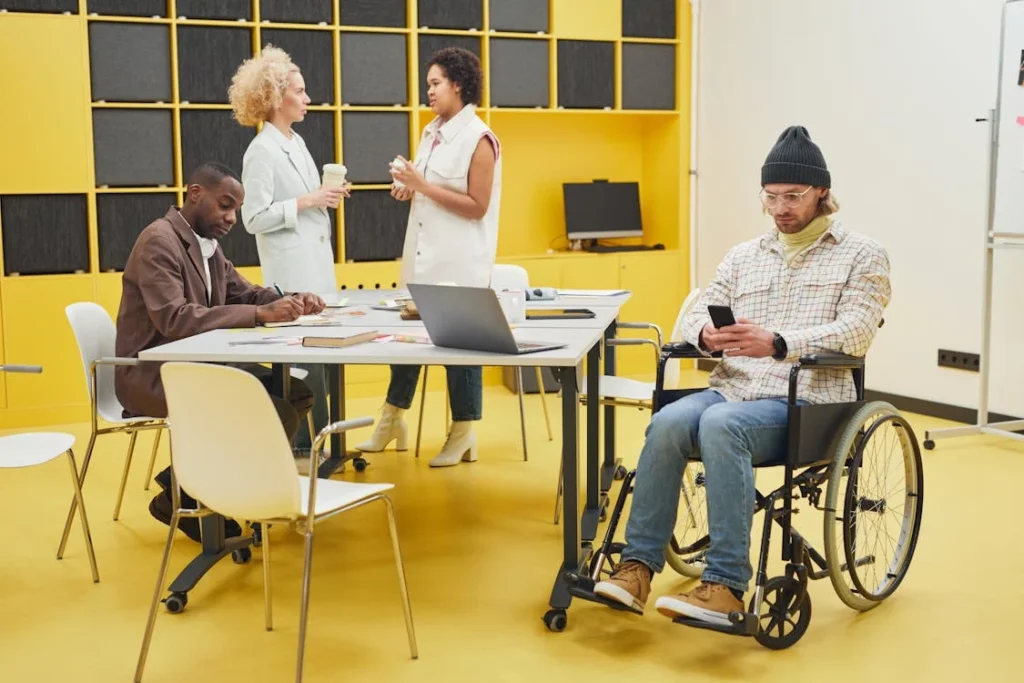An inclusive workplace is not just a moral responsibility—it is a business advantage. When companies create an environment where disabled employees feel valued and empowered, they unlock talent, innovation, and diverse perspectives that drive growth.
The Human Resources (HR) team plays a critical role in making this happen. From hiring to workplace accessibility and ongoing support, HR ensures that employees with disabilities have equal opportunities to thrive. But inclusion is not just about policies; it is about creating a workplace culture where everyone feels respected and supported.

The Role of HR in Hiring Disabled Employees
Hiring is the first step in building an inclusive workplace, and HR plays a central role in ensuring that candidates with disabilities are given fair opportunities.
Many companies unknowingly create hiring processes that exclude disabled applicants, either due to inaccessible application systems or unconscious bias. HR must proactively remove these barriers and create a recruitment strategy that welcomes talent from all backgrounds.
Creating Inclusive Job Descriptions
A job description is often the first interaction a potential employee has with a company. If it is not written with inclusivity in mind, talented disabled candidates may feel discouraged from applying.
HR should ensure that job postings use clear, straightforward language and focus on essential skills rather than unnecessary physical requirements.
For example, instead of saying, “Must be able to lift 20 pounds,” consider, “Must be able to transport materials as needed, with or without reasonable accommodations.”
It is also helpful to include a statement that explicitly welcomes applications from disabled candidates.
Something as simple as, “We are committed to diversity and inclusion and encourage candidates with disabilities to apply,” can make a big difference in making applicants feel welcome.
Making the Application Process Accessible
Even before an interview takes place, disabled candidates may face obstacles in the application process. HR should ensure that the company’s career portal is accessible to screen readers, has clear navigation, and allows alternative ways to apply if needed.
Some applicants may require accommodations such as longer time to complete assessments or the option to submit a video application instead of a written one.
Providing a direct contact for accommodation requests is another way to show commitment to inclusion.
A simple message like, “If you need an accommodation during the application process, please contact our HR team at [email],” can reassure candidates that their needs will be respected.
Conducting Inclusive Interviews
Interviews should focus on evaluating a candidate’s skills and potential, not their disability. HR should train hiring managers on how to conduct inclusive interviews, emphasizing that assumptions about what a candidate can or cannot do should never replace direct discussions.
Interview locations should be accessible, with ramps, elevators, and accessible seating. For virtual interviews, HR should offer captioning or sign language interpretation if needed.
Some candidates may request accommodations such as extended time for assessments or a written format instead of a verbal interview. Accommodating these requests ensures that candidates are evaluated fairly.
Addressing Unconscious Bias in Hiring
Unconscious bias can negatively impact hiring decisions, even among well-meaning employers. Many people hold stereotypes about disability, assuming that disabled employees are less capable, less productive, or require excessive accommodations.
HR must actively work to eliminate these biases by training hiring managers and recruiters to focus on skills, experience, and potential rather than preconceived notions.
One effective strategy is using structured interviews where all candidates are asked the same questions. This reduces subjective judgments and ensures that every applicant is evaluated fairly.
Another approach is implementing blind resume screening, where personal details such as names, photos, and disability disclosures are removed to prevent bias from influencing decisions.
Partnering with Organizations for Inclusive Hiring
HR teams can expand their reach by partnering with organizations that specialize in disability employment.
In India, groups like Enable India, National Centre for Promotion of Employment for Disabled People (NCPEDP), and other advocacy groups help connect companies with skilled disabled professionals.
These organizations provide training, job placement assistance, and guidance on workplace accommodations, making it easier for companies to hire inclusively.
By taking these steps, HR ensures that hiring processes do not unintentionally exclude disabled candidates. But recruitment is just the beginning—creating an inclusive workplace goes beyond hiring.
The next step is ensuring that employees with disabilities feel supported, valued, and empowered to succeed.

Creating an Accessible and Supportive Work Environment
Hiring disabled employees is just the first step. To retain talent and help employees succeed, HR must ensure that the workplace is accessible and supportive.
This includes physical accessibility, assistive technology, workplace accommodations, and fostering an inclusive culture.
Ensuring Physical Accessibility
A truly inclusive workplace is one where every employee, regardless of their physical abilities, can move around freely and perform their tasks without unnecessary obstacles.
HR must ensure that office spaces, meeting rooms, restrooms, and common areas comply with accessibility standards. This means:
- Providing ramps, elevators, and automatic doors for employees with mobility impairments.
- Ensuring hallways and doorways are wide enough for wheelchair users.
- Installing accessible restrooms with grab bars and adequate space for maneuverability.
- Ensuring desks, chairs, and workstations can be adjusted to accommodate different needs.
HR should regularly conduct accessibility audits to identify and fix barriers that may prevent disabled employees from feeling comfortable and independent at work. If a company operates remotely, accessibility still matters.
Employees should have access to captioning services, screen readers, and other necessary tools to perform their jobs effectively.
Providing Assistive Technology and Workplace Accommodations
Every employee has different needs, and HR should be proactive in providing reasonable accommodations. Accommodations vary depending on the individual, but they could include:
- Screen readers or magnification software for employees with visual impairments.
- Speech-to-text software or sign language interpreters for employees who are deaf or hard of hearing.
- Adjustable desks and ergonomic chairs for employees with mobility challenges.
- Flexible work hours or remote work options for employees with medical conditions that require rest or treatment.
One common misconception is that workplace accommodations are expensive or difficult to implement. However, studies show that most accommodations cost little to nothing and provide significant benefits in employee productivity and retention.
HR should create a clear, transparent process for employees to request accommodations without fear of judgment or discrimination.
Creating an Inclusive Workplace Culture
Policies and accommodations are important, but inclusion is about more than just infrastructure—it is about creating a culture where disabled employees feel respected and valued.
HR must lead the effort in fostering a culture of inclusivity by encouraging open conversations about disability, reducing stigma, and promoting equal opportunities.
One way to achieve this is through employee resource groups (ERGs) for disabled employees. ERGs provide a space where employees can connect, share experiences, and advocate for workplace improvements.
HR can support these groups by providing funding, resources, and direct communication channels with leadership.
Training is also key to building a culture of inclusion. HR should organize workshops and training sessions to educate employees about disability etiquette, inclusive communication, and unconscious bias.
Simple things like using respectful language, avoiding assumptions about what disabled employees can or cannot do, and being mindful of accessibility needs can make a big difference.
Encouraging Inclusive Leadership and Representation
A workplace can only be truly inclusive if leadership reflects diversity. HR should actively work to promote disabled employees into leadership roles, ensuring that decision-making processes include voices from diverse backgrounds.
Mentorship programs can help disabled employees navigate career growth and feel supported in their professional journeys. HR can facilitate mentorship by pairing employees with leaders who understand their challenges and can offer guidance.
When disabled employees see others like them in leadership positions, it sends a strong message that their contributions are valued and their growth is encouraged.
By creating an accessible, supportive, and inclusive work environment, HR not only benefits disabled employees but also strengthens the organization as a whole.
Employees who feel respected and accommodated are more engaged, productive, and loyal. However, inclusion does not stop at the workplace—it extends to professional development and career advancement.

Professional Growth and Career Advancement for Disabled Employees
Inclusion in the workplace isn’t just about hiring and accommodations—it’s about ensuring that disabled employees have the same opportunities to grow, develop, and advance in their careers.
HR plays a crucial role in removing barriers that may prevent disabled employees from reaching leadership positions and fulfilling their professional potential.
Providing Equal Access to Training and Development
Every employee, regardless of their abilities, should have access to training programs, skill development opportunities, and leadership courses.
However, many traditional training programs are not designed with accessibility in mind. HR must ensure that all training sessions, workshops, and e-learning modules are fully accessible.
For employees with visual impairments, materials should be available in screen-reader-friendly formats or provided in Braille. Employees who are deaf or hard of hearing should have access to sign language interpreters, captioning, or transcripts for videos.
Training sessions should be held in physically accessible spaces, and online learning platforms should be designed with inclusivity in mind.
HR should also encourage and sponsor disabled employees to attend industry conferences, networking events, and professional certifications.
Often, these opportunities are overlooked for disabled employees due to assumptions about travel challenges or participation barriers. By actively supporting their growth, HR ensures that all employees, regardless of disability, can continue to develop their skills.
Creating Fair and Inclusive Promotion Policies
One of the biggest challenges disabled employees face is the lack of representation in leadership roles. Many companies unknowingly overlook disabled employees for promotions due to unconscious bias or misconceptions about their abilities.
HR must ensure that performance evaluations and promotion decisions are based on merit, skills, and contributions rather than assumptions about what a disabled employee can or cannot do.
HR should:
- Conduct bias training for managers to prevent discriminatory decision-making in promotions.
- Ensure promotion criteria are transparent, measurable, and equally applied to all employees.
- Provide mentorship and leadership training specifically designed for disabled employees to prepare them for higher roles.
- Encourage disabled employees to take on high-visibility projects and leadership responsibilities.
It’s important that HR communicates clearly that disability is not a barrier to career growth. When employees see their colleagues with disabilities advancing in the company, it fosters a culture of inclusion and motivation.
Encouraging Allyship and Peer Support
While HR plays a leading role in inclusion efforts, it is equally important to engage all employees in creating a supportive work environment. Encouraging allyship among colleagues helps create a workplace where disabled employees feel seen, heard, and supported.
HR can facilitate allyship through awareness programs, disability inclusion events, and storytelling initiatives where disabled employees share their experiences.
Peer support groups, mentorship programs, and networking opportunities can also help disabled employees build relationships and feel more connected within the organization.
Managers should also be trained to recognize and address any workplace barriers that may arise.
Instead of assuming what an employee needs, managers should be encouraged to have open and respectful conversations with their team members about how they can best support them in their roles.
Measuring Inclusion and Making Continuous Improvements
To build a truly inclusive workplace, HR must regularly assess the company’s progress in disability inclusion. This can be done through:
- Employee feedback surveys that specifically ask about accessibility and inclusion.
- Reviewing hiring, retention, and promotion data to ensure disabled employees are advancing at the same rate as their peers.
- Conducting focus groups with disabled employees to understand their experiences and identify areas for improvement.
- Partnering with disability advocacy groups to stay updated on best practices and industry standards.
Inclusion is not a one-time initiative—it’s an ongoing commitment. By continuously assessing and improving workplace policies, HR can ensure that disabled employees feel supported throughout their careers.
The Long-Term Benefits of Disability Inclusion
Creating an inclusive workplace is not just about compliance with legal requirements—it’s about building a stronger, more innovative, and diverse organization. Companies that prioritize disability inclusion benefit from:
- A wider talent pool with diverse perspectives and problem-solving skills.
- Higher employee engagement and morale.
- Improved company reputation and brand image.
- Increased innovation, as inclusive teams bring fresh ideas and unique approaches to challenges.
By making career growth and professional development accessible to all, HR not only empowers disabled employees but also strengthens the company as a whole.
When employees feel valued, supported, and given equal opportunities to succeed, they contribute more effectively and remain committed to the organization for the long term.

Fostering Long-Term Inclusion: Beyond Policies and Compliance
Creating an inclusive workplace for disabled employees is not just about implementing policies—it’s about fostering a culture of long-term inclusion where employees feel valued, respected, and empowered.
HR plays a central role in ensuring that inclusion is embedded into every aspect of the organization, from daily interactions to long-term strategic planning.
Embedding Inclusion in Company Values
A truly inclusive workplace does not treat disability inclusion as a one-time initiative or a box to check—it is a core part of the company’s values and mission.
HR must work closely with leadership to ensure that inclusivity is woven into the company’s identity, influencing decision-making, hiring, career growth, and daily workplace interactions.
This starts with clear messaging from the top. Company leaders should openly discuss their commitment to disability inclusion, reinforcing the idea that diversity strengthens the organization.
Internal communications—such as newsletters, company meetings, and employee handbooks—should regularly highlight success stories of disabled employees, updates on accessibility improvements, and upcoming inclusion initiatives.
HR should also ensure that inclusion is part of performance reviews and leadership evaluations.
Managers and team leaders should be held accountable for creating an inclusive work environment, ensuring that disabled employees receive the same growth opportunities as their peers.
Encouraging Inclusive Social and Team-Building Activities
One of the most overlooked aspects of workplace inclusion is social integration. Many disabled employees feel isolated in workplaces where social events, team-building activities, and informal gatherings are not designed with accessibility in mind.
HR must ensure that all employees, regardless of ability, can participate fully in social and networking opportunities.
For example, if the company organizes an offsite retreat, HR should consider:
- Whether the venue is accessible for employees with mobility challenges.
- Whether sign language interpreters or assistive devices are needed for events.
- Offering a mix of physical and non-physical activities so that everyone can participate.
- Creating an inclusive environment where all employees feel welcome and encouraged to engage.
Even simple team meetings and lunch outings should be planned with accessibility in mind. Something as basic as choosing a wheelchair-accessible restaurant or ensuring a virtual meeting has captions can make a significant difference in making employees feel included.
Building Stronger Disability Allyship
HR cannot drive inclusion alone—it requires support from all employees. A strong culture of allyship ensures that disability inclusion is not just an HR-led initiative but a company-wide commitment.
HR should encourage allyship through training programs, awareness campaigns, and employee-led inclusion committees. Employees should be educated on:
- The importance of using inclusive language and avoiding offensive or outdated terminology.
- How to offer help respectfully without making assumptions about a disabled colleague’s needs.
- Recognizing and calling out ableism in the workplace, whether it’s an inaccessible policy or an unconscious bias in decision-making.
When all employees understand their role in fostering inclusion, it creates a work environment where disabled employees feel comfortable, empowered, and supported.
Partnering with External Disability Organizations
HR teams can enhance their disability inclusion efforts by collaborating with external organizations that specialize in accessibility and disability advocacy.
Partnerships with groups such as Enable India, NCPEDP, and disability rights organizations provide valuable insights, training, and recruitment opportunities.
Companies can also participate in disability job fairs, mentorship programs, and inclusion awards to showcase their commitment to an inclusive workforce.
These partnerships not only help in hiring but also demonstrate a company’s long-term dedication to accessibility and diversity.
The Business Case for Disability Inclusion
While fostering an inclusive workplace is primarily about fairness and respect, it also brings tangible business benefits. Companies that prioritize disability inclusion often experience:
- Higher Employee Retention – When employees feel valued and supported, they are more likely to stay with the company long-term.
- Increased Innovation – Diverse teams bring fresh perspectives and creative problem-solving approaches, driving business growth.
- Enhanced Brand Reputation – Consumers and clients increasingly support businesses that champion diversity and inclusion.
- Better Compliance with Regulations – Proactively addressing accessibility and disability inclusion ensures compliance with workplace laws, reducing legal risks.
By making disability inclusion a business priority rather than an afterthought, companies set themselves up for long-term success while fostering a work environment where every employee has the opportunity to thrive.

The Role of HR in Mental Health and Invisible Disabilities
When discussing disability inclusion, physical accessibility often takes center stage. However, not all disabilities are visible. Employees with mental health conditions, neurodivergent traits, or chronic illnesses often face unique challenges in the workplace that require HR’s attention.
HR teams must ensure that inclusion efforts extend to employees with invisible disabilities, such as anxiety, depression, autism, ADHD, chronic pain, or autoimmune disorders. These employees may not require physical accommodations but still need support to thrive in their roles.
Creating a Workplace Culture That Supports Mental Health
Mental health is just as important as physical health in the workplace, yet stigma often prevents employees from seeking support.
HR can foster a mentally healthy workplace by normalizing conversations about mental health and ensuring employees feel safe discussing their challenges without fear of discrimination.
HR should consider:
- Confidentiality and Psychological Safety – Employees should feel secure in discussing mental health concerns without the fear of negative consequences. HR must handle disclosures with strict confidentiality and ensure managers do the same.
- Flexible Work Arrangements – Many employees with mental health conditions or chronic illnesses benefit from remote work, flexible hours, or modified workloads during difficult periods. HR should create policies that allow employees to request adjustments without stigma.
- Mental Health Awareness Training – Educating managers and employees about mental health conditions reduces stigma and fosters a supportive environment. Leaders should be trained on recognizing signs of mental distress and providing appropriate support.
Accommodations for Neurodivergent Employees
Neurodivergent employees, including those with autism, ADHD, or dyslexia, bring valuable skills to the workplace but often struggle with traditional work environments.
HR can support neurodivergent employees by making adjustments that improve focus, productivity, and comfort.
Some effective accommodations include:
- Quiet Workspaces – Open office environments can be overwhelming for employees sensitive to noise or distractions. Offering noise-canceling headphones or quiet areas can help.
- Clear Communication and Instructions – Neurodivergent employees may prefer written instructions, structured schedules, and clear expectations to minimize misunderstandings.
- Alternative Interview Methods – Traditional job interviews can be challenging for neurodivergent candidates who struggle with eye contact or social interactions. HR can offer alternative assessment methods that focus on skills rather than social performance.
- Adjustments to Performance Reviews – Standard performance reviews often prioritize traits like verbal communication or fast decision-making, which may not align with neurodivergent work styles. HR should ensure that performance evaluations are fair and recognize diverse strengths.
Supporting Employees with Chronic Illnesses
Employees with chronic illnesses, such as autoimmune disorders, fibromyalgia, or long-term medical conditions, may experience fluctuating health that impacts their work. HR should ensure that these employees feel supported rather than penalized for health-related challenges.
Key strategies include:
- Paid Sick Leave and Health Benefits – Employees should not have to choose between their health and job security. Offering sufficient paid sick leave and comprehensive health benefits ensures they receive necessary medical care.
- Flexible Deadlines and Task Adjustments – Chronic illness symptoms can be unpredictable. Allowing employees to adjust deadlines or redistribute tasks during flare-ups can help them manage their workload effectively.
- Remote Work Options – Many employees with chronic conditions benefit from remote work to reduce fatigue and exposure to infections. Offering remote or hybrid work options can significantly improve their quality of life.
Promoting an Inclusive Workplace for All Disabilities
HR should ensure that disability inclusion policies are broad enough to support both visible and invisible disabilities. This means reviewing policies to confirm they cover mental health, neurodivergence, and chronic illness alongside physical disabilities.
By recognizing and addressing the unique challenges of invisible disabilities, HR creates a truly inclusive environment where all employees feel supported and empowered.
This approach not only improves employee well-being but also enhances retention, engagement, and overall workplace satisfaction.

The Role of HR in Crisis Management and Emergency Preparedness for Disabled Employees
While companies focus on day-to-day inclusion efforts, one often-overlooked aspect of workplace accessibility is emergency preparedness.
HR plays a critical role in ensuring that employees with disabilities are safe, informed, and supported in times of crisis, whether it’s a natural disaster, fire, medical emergency, or unexpected workplace disruption.
Developing Inclusive Emergency Plans
Standard emergency evacuation plans often fail to consider the needs of disabled employees. HR must work with facility managers, safety officers, and employees with disabilities to create an inclusive emergency response strategy. Key considerations include:
- Alternative Evacuation Routes – Staircases, narrow hallways, and heavy doors can be barriers for employees with mobility impairments. HR must ensure that accessible exits, ramps, and elevators (where safe) are incorporated into emergency plans.
- Assistance Protocols – Some employees may need assistance evacuating or reaching safety during an emergency. HR should establish designated support teams, ensuring employees know who to turn to for help.
- Emergency Communication Accessibility – Alarm systems should include visual and auditory alerts for employees who are deaf or hard of hearing. HR should also provide real-time captions for emergency announcements and text-based updates for those who cannot hear alarms.
- Medical Emergency Response – Employees with conditions like epilepsy, diabetes, or severe allergies may require immediate medical attention in an emergency. HR should ensure that first responders and workplace medical kits are equipped to handle these situations.
Conducting Inclusive Emergency Drills
Emergency drills are essential for preparedness, but they are often designed without considering disabled employees’ needs.
HR should organize regular drills that include everyone, ensuring that employees with disabilities can practice safe evacuation or shelter-in-place procedures.
Some key steps include:
- Informing Employees About Drill Procedures in Advance – Employees with anxiety, sensory sensitivities, or mobility impairments may require additional preparation before participating in a drill.
- Assigning Emergency Buddies – Pairing employees with trained colleagues ensures that those needing assistance are not left behind during an emergency.
- Testing Alternative Communication Methods – Ensuring that all emergency announcements are accessible through multiple channels, including text, email, and visual signals.
Remote Work and Crisis Preparedness
In situations like public health emergencies (e.g., COVID-19), HR must ensure that disabled employees have equal access to remote work options. This means:
- Ensuring that all employees have access to assistive technology at home.
- Providing mental health support for employees who may struggle with isolation.
- Implementing policies that allow for flexibility in work hours and deadlines during crises.
By proactively including disabled employees in crisis planning, HR ensures that every team member remains safe and supported, no matter the situation.
Conclusion
Building an inclusive workplace for disabled employees is not just about meeting legal requirements—it’s about creating a culture of respect, belonging, and equal opportunity. HR plays a crucial role in every step of this journey, from inclusive hiring practices to accessible work environments, career advancement, and company-wide cultural shifts.
True inclusion happens when every employee, regardless of ability, feels empowered to contribute their skills, grow in their career, and be fully integrated into the workplace. Companies that embrace disability inclusion don’t just change the lives of their employees—they build stronger, more innovative, and more successful organizations.
Now is the time for HR leaders to take action. By prioritizing accessibility, fostering allyship, and embedding inclusion into company values, businesses can create workplaces where every employee, disabled or not, can reach their full potential.



